Excerpts from Jim Conrad's
Naturalist Newsletter
entry from field notes dated October 8, 2022, taken about 3kms north of Gómez Farías, on the lower eastern slope of the Eastern Sierra Madres, El Cielo Biosphere Reserve, southern Tamaulipas state, MÉXICO; elevation about 300m (1000 ft), ± LAT. 23.04°N, LONG. -99.15°W
NOT-PURPLE PURPLE SPIDERWORT
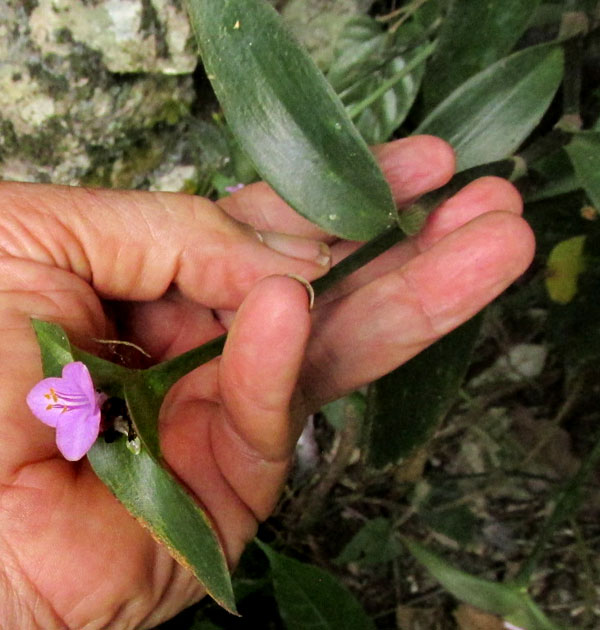
At the base of a limestone boulder in woods beside the gravel road into Cañón el Azteca, the above spiderwort was flowering. People know spiderworts by sight because they're commonly cultivated as ornamentals worldwide, though usually those plants are colorfully variegated or their vegetative parts are one bright color. Spiderworts are the genus Tradescantia of the Spiderwort Family, the Commelinaceae, native to the tropics in both the New and Old World.
However, the Spiderwort Family embraces about 731 known species in 41 genera, and genus Tradescantia holds about 85 species, all native to the Americas, of which about 42 are found in Mexico. Therefore, you never know when you'll find one that's new to you, so checking the details can be rewarding. In the above picture, important field marks include the plant's stem's more or less reclining on the ground, and the flowering head arising from a cupped depression between two flaring, leaf-like bracts, which are smaller than the stem leaves below them. The flowers and bracts appear at the tip of an elongated peduncle.
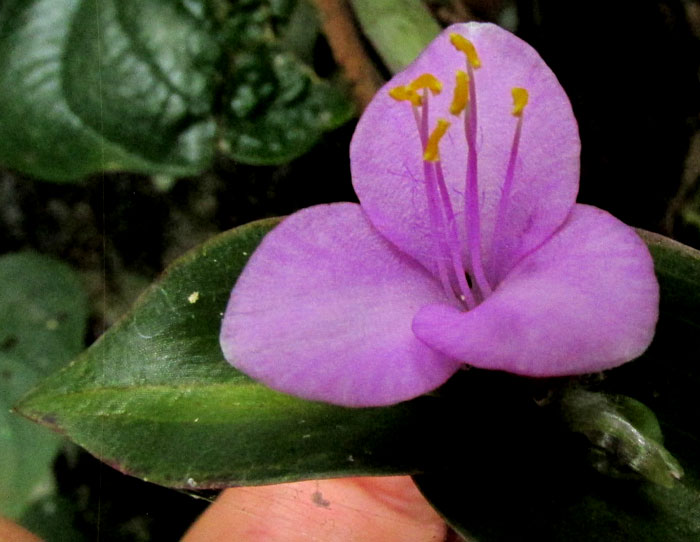
The flowers display a shape and color typical of many spiderwort species. However, this flower's anthers are yellow, while some species produce different colored ones.
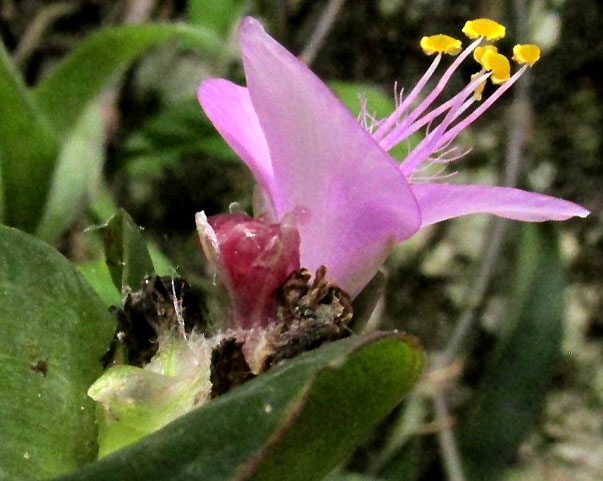
From the side it's seen that the filaments are sparsely long-hairy. Note the anthers' structure, displaying a broad connective between each anther's pollen-releasing anther sacs. At the flower's base, on the left, an unopened, dark purple flower rests between three almost-transparent sepals.
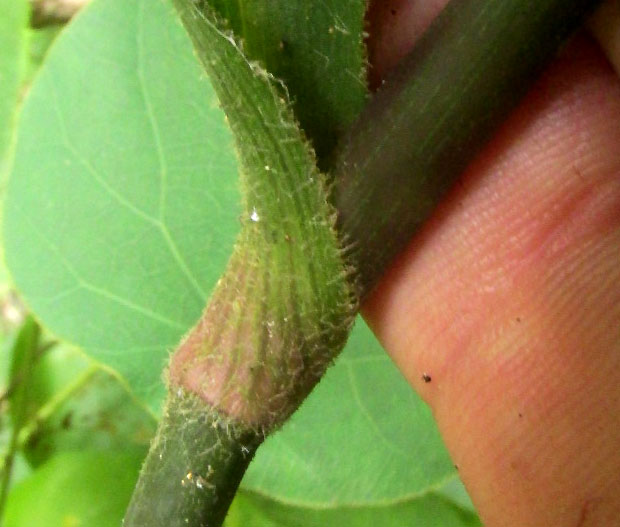
Each leaf blade's base briefly wraps around the stem, forming a short sheath, before ending at the stem node. The leaves and stem are sparsely hairy in some places, almost hairless in others. Note that the blade sheath displays a very faint purple hue.
The above features, including the faint purple hue, all lead us to TRADESCANTIA PALLIDA, often known as the Purple Spiderwort. Purple Spiderworts are grown ornamentally worldwide, in gardens and as potted plants, often as hanging plants. However, nearly always the form that cultivated, and frequently escaped into the wild, produces deep purple leaves and stems (see the following entry). In the Yucatan the purple form was a common weed, with the green form seldom seen.
The distribution map on the gbif.org Tradescantia pallida page shows where this species has been documented -- nearly worldwide. However, the species is native just to central Mexico. Here we're finding original stock of the gaudy form planted worldwide, and gone wild in the warmer parts.
The 2014 publication by Joash Ban Lee Tan and others, entitled "Antioxidant Content, Antioxidant Activity, and Antibacterial Activity of Five Plants from the Commelinaceae Family," note Purple Spiderwort for its ability to effectively remove volatile organic pollutants from the air, and its traditional medicinal use as an anti-inflammatory and anti-toxic supplement, and to improve blood circulation.
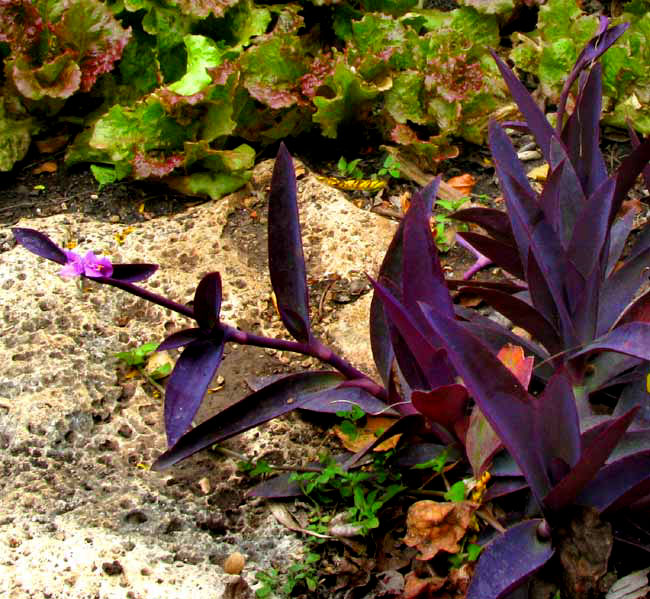
from the March 27, 2011 Newsletter issued from Hacienda Chichen Resort beside Chichén Itzá Ruins, central Yucatán, MÉXICO; limestone bedrock, elevation ~39m (~128ft), ~N20.676°, ~W88.569°
PURPLE SPIDERWORT
Above you can see an attractive, purple-leafed, foot-tall herb doing very well growing in thin soil in cracks in the bedrock limestone outcropping in my front yard. A close-up of one of its pale purple, three-petaled, six-stamened flowers can be seen below:
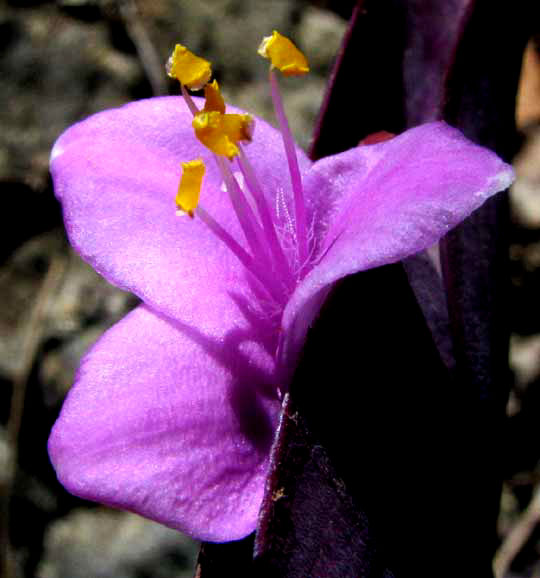
That flower looks like it's emerging from some kind of slit, and it is -- from a long, narrow opening between edges of a branch-tip, folded-together leaf, as shown below:
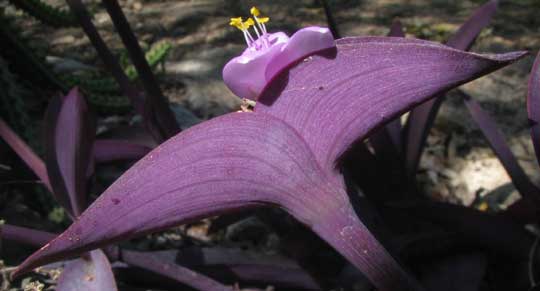
Often grown as an ornamental in gardens, along borders, as ground cover and as a hanging plant, this plant goes by lots of English names. Maybe its most common one is Wandering Jew, but that name is shared by so many similar species that it's practically useless if you need to look up the plant. Other names include Purple Spiderwort, Purple Heart and Purple Queen. It's TRADESCANTIA PALLIDA of the Spiderwort Family, the Commelinaceae, native to Mexico's Gulf Coast region, but apparently not to the Yucatán.
The pretty flowers last for only one day, but usually a new blossom emerges from the slit the previous day's flower arose from, day after day for a good while. Older leaves die back leaving naked stems, which can give the plant a leggy look, but the plant is so vigorous that scraggly parts can be pulled out and new sprouts quickly form dense, new growth. If you're in a frost-free zone, however, be careful, because discarded stems often root and grow. In southern Florida, Australia and other places Purple Spiderwort is regarded as an invasive, hard-to-control weed.
In my front yard, however, its purple herbage is very pretty against the white limestone, and it thrives where other less vigorous plants wither from the limestone's reflected light and heat.